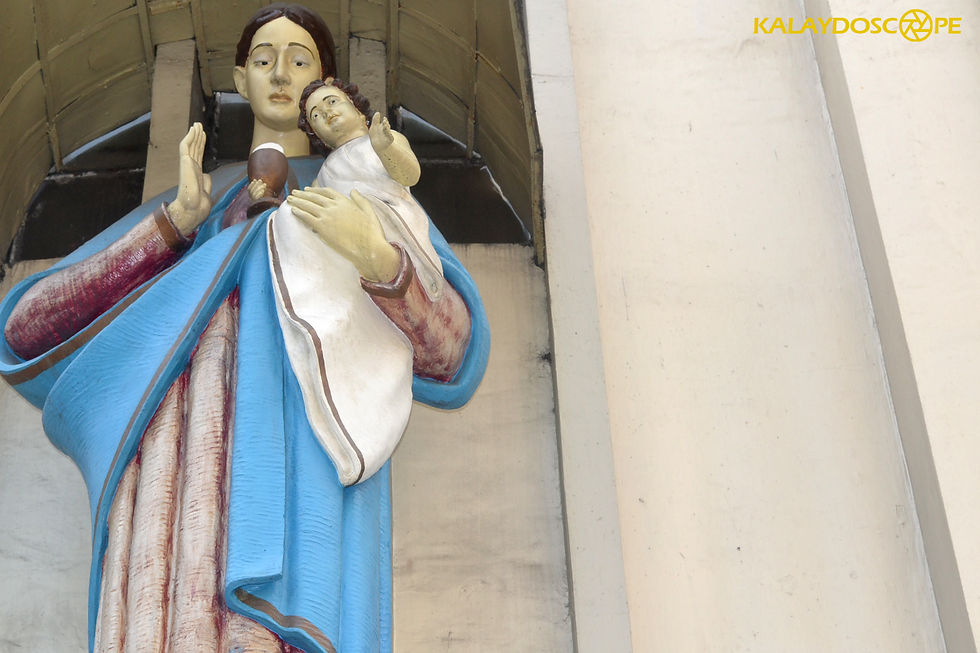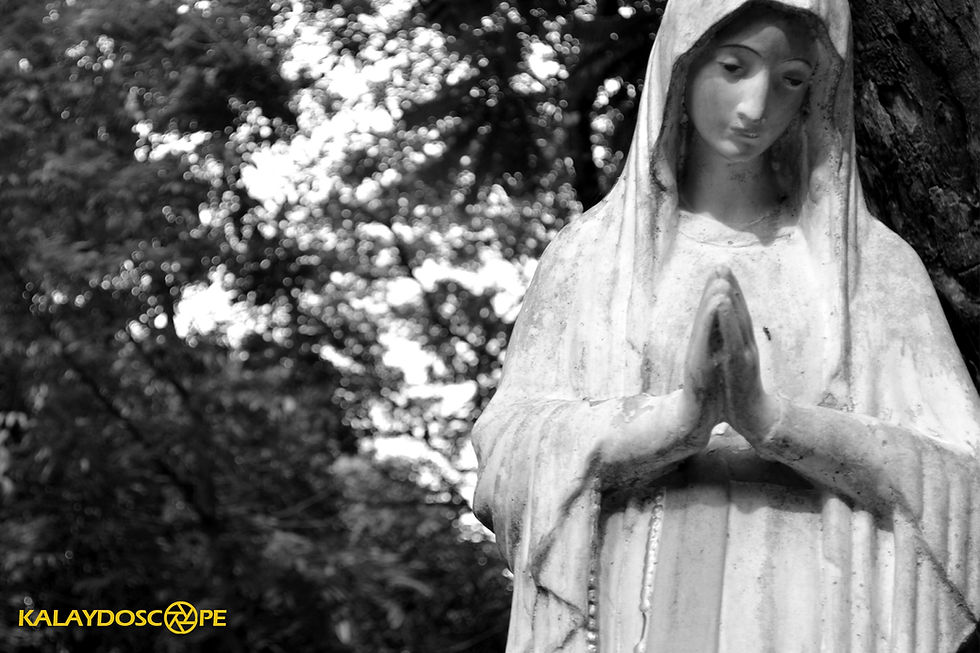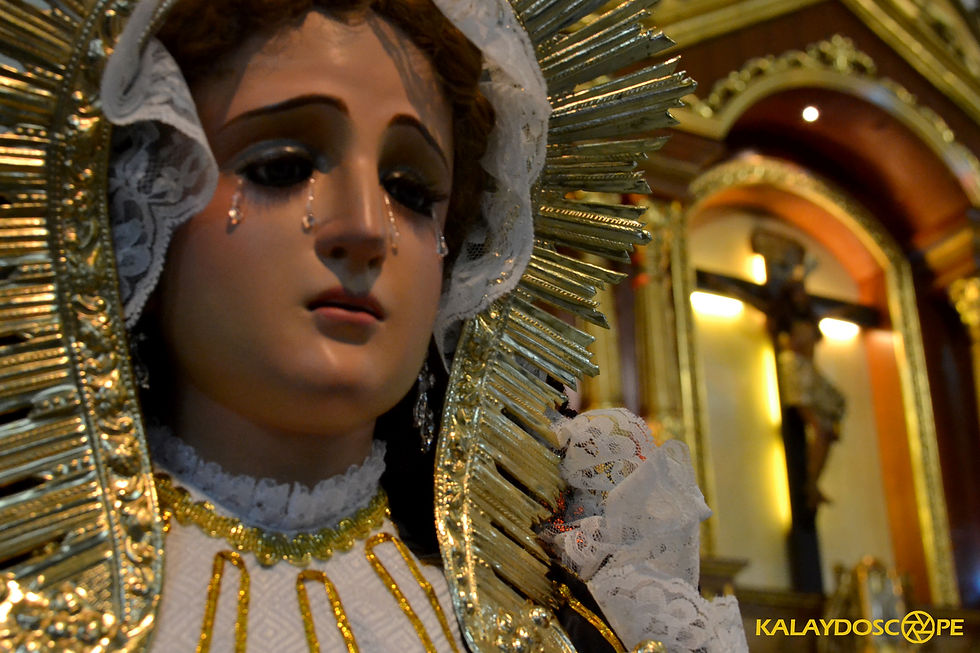Marian Devotion: Why Bother? | Fr. Kevin Joshua Cosme
- Dominus Est!
- May 27, 2020
- 9 min read
Updated: Apr 10, 2023
This month of May, dedicated to the Blessed Mother, is a good time to think about the Church’s centuries’ old devotion to Mary and what she means to us on a personal level. Many of our Christian brethren don’t understand why we bother with Mary and the saints in the first place where we could be going directly to Jesus instead.
Here are four of my answers to the question as to why we should bother with Marian devotion at all. Take a deep breath as you’re in for a pretty long dive!

Our Lady of the Eucharist | Sta Cruz Church
1. SHE DESERVES ALL THE LOVE.
Mary has been given numerous titles throughout the centuries, many of which like “Mother of Perpetual Help” and “Our Lady of Guadalupe” are familiar to us Filipinos. But her arguably greatest title, and the basis of all her prerogatives, is her claim to being the “Mother of God”. It is so pivotal that we celebrate it as a solemnity on January 1, the start of each calendar year.
Admittedly, the term “Mother of God” has raised not a few eyebrows. The title goes all the way back to 431 AD, when the Council of Ephesus declared Mary as “Theotokos,” a Greek term meaning “God-bearer” or more colloquially, “Mother of God”. At its heart, it does not actually propose that Mary is God but that Jesus is God. If the man Christ is also God, then Mary, who conceived and gave birth to Christ, is rightly called the Mother of God. Note that mothers do not create their children, because creation is something only God can do. So it is appropriate to call Mary the Mother of God because she conceived, bore, and raised Jesus, whom we Christians profess as being fully God and fully man in one person.
I once posted a tribute to my own mother on Facebook and was pleasantly surprised when it was met with overwhelming approval. People showered my mother with praises. They said she looked like a certain actress and that I was fortunate to have such a good mother. Did I perhaps take offense because of all the attention she was getting? Of course not! On the contrary, I was smiling from ear to ear as I went through the comments, delighted that people were recognizing her. Is it not the same with God when He sees us praising His mother?
Nevertheless, we must make a distinction between the levels of honor we accord to certain persons, denoted by the Greek words latreia, dulia, and hyperdulia. (These distinctions were made as early as St. Augustine and were expounded in greater detail by St. Thomas Aquinas). Latreia (Latin latria) is translated as adoration, the highest homage given only to God. Dulia is translated as reverence, the honor we accord to the saints because of their exceeding dignity. Hyperdulia is an elevated form of reverence shown only to the Blessed Virgin Mary, the most excellent of all the saints. Thus, we worship and offer sacrifice only to the Holy Trinity. But we honor the saints and exceedingly reverence Mary, the Mother of God.
2. CHRISTIANS HAVE BEEN DEVOTED TO HER SINCE THE BEGINNING.
Aside from being present at key points in Jesus’ life – she was, for example, among the few of his disciples who was courageous enough to be at the foot of the cross (John 19:25) – she also accompanied and prayed with the disciples, leading up to Pentecost (Acts 1:13-14; 2:1-4). We can imagine the small band of disciples huddled in the upper room, learning so much about Jesus – about his life, about discipleship to him, and about prayer – from Mary, whose attitude toward the life of Jesus was to keep everything in her heart (Luke 2:19). From the very beginning, she was already mother to the Church.
Among the earliest reflections on the role of Mary are the writings of St. Justin the Martyr and St. Irenaeus of Lyons, contemporaries from the 2nd century. They lived so close to the time of the apostles that Irenaeus could write, “As I heard from a presbyter, who had heard it from men who had seen the apostles…” These two great Church Fathers characterize Mary as the new Eve who played a crucial albeit secondary role to that of Christ, the new Adam. Adam and Eve were from the first creation, but their disobedience brought sin and death to the world. Christ and Mary are portrayed as the new Adam and the new Eve, signaling the start of a new creation and succeeding where the first pair did not. “For since death came through a human being, the resurrection of the dead came also through a human being. For just as in Adam all die, so too in Christ shall all be brought to life” (1 Corinthians 15:21-22).
So Mary is revered not simply for being Jesus’ biological mother, but also for her active, game-changing role in redemption. Whereas Eve disobeyed God and conceived death, Mary submitted her will to God and conceived Life. Just imagine all of creation developing for billions of years to make possible that moment when Mary could choose whether to submit to God’s will or not. If she had not given her fiat, the Savior would not have been born of her, and we would have all been screwed! But she chose to trust in God, living out that difficult, devoted fiat all throughout her life. “And thus it was that the knot of Eve’s disobedience was loosed by the obedience of Mary,” as Irenaeus put it. (Note here the theological basis of the devotion to Mary, the Untier of Knots, held dear in Argentina and popularized by the Argentinian Pope Francis). Christians have every reason to be thankful to her, and indeed the Church has been from the very beginning!

Our Lady of the Poor | San Carlos Seminary
3. SHE IS THE FACE OF DISCIPLESHIP.
A story peculiar to Luke’s gospel may leave us wondering about Mary’s dignity. “While [Jesus] was still speaking, a woman from the crowd called out and said to him, ‘Blessed is the womb that carried you and the breasts at which you nursed.’ He replied, “Rather, blessed are those who hear the word of God and observe it” (Luke 11:27).
Is Jesus dissing his own mother? Let’s make it worse by citing another controversial passage, this time from Matthew’s gospel. “While he was still speaking to the crowds, his mother and his brothers appeared outside, wishing to speak with him. Someone told him, ‘Your mother and your brothers are standing outside, asking to speak with you.’ But he said in reply to the one who told him, ‘Who is my mother? Who are my brothers?’ And stretching out his hand toward his disciples, he said, ‘Here are my mother and my brothers. For whoever does the will of my heavenly Father is my brother, and sister, and mother” (Matthew 12:46-50; Mark 3:31-35).
Doesn’t that sound like a slap in the face from an ungrateful son? Except it’s not, especially when you realize that Jesus wasn’t disowning his mother, but honoring her. For Jesus, biological relations meant little where the reign of God was concerned. The family of disciples he was forming was bonded not by blood but by adherence to the will of God, “for whoever does the will of my heavenly Father is my brother, and sister, and mother.” And do you know who aside from Jesus perfectly heard the word of God and observed it? That’s right, Mary! Mary was Jesus’ first and most perfect disciple. At the Annunciation, she welcomed the Word of God in her heart before she conceived Him in her womb, as St. Augustine observed.
In light of this, we can understand Mary’s honorable title as Mother of God in a more nuanced way. She is great not because of biological motherhood, but because of faith, without which it is impossible to please God (Hebrews 11:6). In fact, she was so pleasing to God that the angel Gabriel called her “full of grace,” or “highly favored one” (Luke 1:28). It was this faith that allowed her to become God’s mother in the first place.
Mary’s unwavering faith is a model to disciples everywhere. To take but a few examples, at the Annunciation she demonstrates the lifelong stance of every disciple in regard to the often mysterious will of God: fiat, “may it be done!” (Luke 1:38). She shows us what to do in times of crisis as in the wedding at Cana: preserve full confidence in Jesus and “do whatever he tells you” (John 2:5), an attitude that enables Jesus to work his miracles! Finally, she reveals to us how far a true disciple is willing to go to accompany the Master: all the way to the cross. Mary was among the few who did not desert Jesus in his hour of greatest need but was there at the foot of the cross, tortured in a way that only a mother beholding her dying Son could be. And yet she still held on to faith, perhaps whispering a pained but resolute fiat to all that was happening. And her faith was not in vain, for God meets such faith with an experience of resurrection.
Everyone is called to be Jesus’ disciple. If you want to know how it’s done, look to Mary.
4. JESUS GAVE US THE BEST MOM EVER!
Among Jesus’ final works before expiring on the cross was entrusting his mother to the beloved disciple. “Standing by the cross of Jesus were his Mother and his mother’s sister, Mary the wife of Clopas, and Mary of Magdala. When Jesus saw his mother and the disciple there whom he loved, he said to his mother, ‘Woman, behold your son.’ Then he said to the disciple, ‘Behold, your mother.’ And from that hour the disciple took her into his home” (John 19:25-27).
This passage may be interpreted both literally and symbolically. On the literal level, Jesus showed his concern for his mother’s welfare by entrusting her to the beloved disciple, which would have been quite unnecessary if Jesus had siblings and if Joseph were still alive. Symbolically, Jesus was entrusting his mother to the church, represented by the unnamed beloved disciple, and the church to his mother. This requires some explanation.
In the Gospel of John, the only two times that the mother of Jesus appears are at the beginning and the end, in the wedding at Cana and at the crucifixion. This is a Hebraic literary technique called “inclusion,” where an element appears at the start and at the end and so is implied to have been there all throughout. Thus, Mary is understood as having been with Jesus throughout his ministry, in fact even setting it off at the wedding at Cana (John 2:1-12). Mary notices a potentially embarrassing situation for the newlyweds and informs Jesus that “they have no more wine.” Jesus’s response is strange: “Woman, how does your concern affect me? My hour has not yet come.”
Jesus’ “hour” is his moment of glorification on the cross. When it does arrive, Mary is there once more, and Jesus again calls her, “woman”. To understand this strange form of address, we have to return to Genesis, the first book of the bible. After the sin of Adam and Eve, God tells the serpent that “I will put enmity between you and the woman, and between your offspring and hers; they will strike at your head, while you strike at their heel” (Genesis 3:15, NRSV).
“They” refers to the woman’s [Eve’s] offspring. The Greek version actually has the masculine pronoun (“he”), so the offspring refers to a particular child of the woman who will definitively crush the serpent, whom Christian tradition understands as the devil (Revelations 12:9). And this offspring is, of course, Jesus, whose “hour” has arrived at the crucifixion. By calling his mother “woman,” Jesus is linking her with God’s promise in Genesis, thereby demonstrating that His death is the act that deals the fatal blow to the serpent. Mary is portrayed, then, as the new Eve.
Just as Eve was called the “mother of all the living” (Genesis 3:20), so Mary, the new Eve, is mother to all of Jesus’s spiritual brethren, for Jesus is the “firstborn among many brothers” (Romans 8;29). As she is mother to Jesus, the Head, so she is mother to the Body, which is the Church (cf. Colossians 1:18).
Following the giving of his mother and of the beloved disciple to each other, the next verse reads: “After this, aware that everything was now finished…” (John 19:28), implying that his entrustment of Mary to the disciple (and to all of us) was a deliberate move on his part that capped everything off. Jesus willed to give us his very own mother.
Imagine having the new Eve, the first and most perfect disciple, the Mother of the Church, and the Mother of God – as your own Mother! And yet on a personal level, Mary will remain Mother of God in a distant way unless one forms the conviction that she is also “my Mother”. To love someone on an intimate basis means getting to know them and spending time with them. Unless we do that with Mary, it’s like keeping at arm’s length this Mother who loves us and cares for our salvation more than we do ourselves.
In the span of time it took for me to research for and write this article, I found myself falling deeper and deeper in love with this lovely woman whom I have come to affectionately call “Mama”. And if you’re worried that she takes anything away from the love we ought to show Jesus, don’t. For as surely as Saturday, the day we dedicate to Mary, leads to Sunday, so does true devotion to Mary unfailingly lead to Jesus.
Ad Jesum per Mariam!

Mater Dolorosa | Holy Cross Parish
*photos by Clyde Ericson Nolasco





Comments